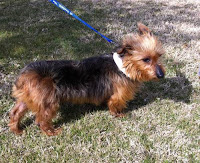Where do Rescue Dogs come from?
by Susan Saulvester
A member, with obvious trepidation, has asked of Australian Terrier Rescue (ATR) “Where do these dogs come from? Is it us?”
First and foremost, ATR can state that rarely is rescue asked to assist with placement of a dog known to be bred by an ATCA member. The Code of Ethics (COE) of the ATCA states that breeders “accept and acknowledge that they have a lifetime responsibility to the breed, to those who purchase their puppies, and to the dogs they produce.” The COE goes on to state that no member may wholesale, sell via wholesale houses, pet outlets, etc. or any speculative source of distribution. It further states “observing the spirit of the Code is as important as adhering to its law.” In order to list with ATCA Breeder Referral, a member must have on file with the breed referral chair a signed copy of ATCA’s COE and also a signed breeder referral compliance form. This includes having a written contract between buyer and seller and a spay/neuter agreement for pet puppies.
In the early years of ATCA, members’ dogs could be found behind some of our most prolific USDA licensed breeders and also backyard breeders of Australian Terriers. Over the years, member education and excellent mentorship of new members by experienced breeders, and yes, peer pressure, has virtually eliminated the breeding stock of ATCA members from the pedigrees of commercial breeders, wholesalers, and pet shop suppliers. Today, if a dog bred by a club member needs assistance from rescue, that club member is notified and must assume responsibility for the dog. If requested, ATR will offer adoption referrals. Failure to assume this responsibility is in violation of our Code of Ethics.
Most dogs that come into rescue are from unknown sources and most of the reasons are not the dog’s fault! One only has to look at them to see that while they are Aussies, they do look different from our dogs in the show ring, but they are still our happy, joyful little breed, in spite of this.
ATR is contacted by public shelters when they receive what they think is an Aussie. ATR works closely with Silky Rescue, Yorkie Rescue, and Cairn Rescue, as these breeds are often misidentified by shelter employees. We are also contacted by private local rescue groups who pull adoptable dogs from high-kill shelters. Most shelters now have either a paid or volunteer adoption coordinator who contacts rescue groups.
Some of the Aussies come from owners who pass away or go into nursing homes. Sometimes, owners are in the military and have to move, often on short notice, to places where they cannot take their dogs. The most common reason, and perhaps the most valid, is that the poor dog is the wrong breed for the wrong person at the wrong time in their life. This seems to be especially true of adult male Aussies.
ATR occasionally finds large numbers of dogs being offered at auction. Reluctantly, we have decide not to pursue this,, as we would be perpetuating commercially licensed dealers by buying their older breeding stock so they are able purchase more and younger dogs. Former breeding dogs are often discarded along the road or found in shelters, primarily in the Midwest.
Pet people may lose the registration papers over time, so they often do not know where their dog came from. Many dogs have been passed around several times by well-intentioned people or adopted from a newspaper ad or from Craig’s List. These dogs have untraceable backgrounds.
Tireless public education on TV, through the media, and networks such as Animal Planet have made the puppy-buying public much more cognizant of purchasing their new family pet from a reputable breeder, one they get to know and stay in touch with. The buying public has become much more demanding and aware of making the proper purchase.
The best way an ATCA a member can be sure that no dog they breed and sell ever becomes homeless is to keep in touch with each puppy buyer for the lifetime of the dog. Sending a note at Christmas or at the time of the litter’s birthday annually is a nice touch. This way, you will find out if there are health problems in your line, which you might not know about otherwise, as the dogs age. Keeping the lines of communication open between yourself and the owners encourages them to come to you with health issues and even behavioral issues. You can share their loss when they tell you that old age has taken their beloved pet. Sometimes people’s lives take a turn in ways they do not anticipate, and letting them know you are always there for that puppy that you sold them can be reassuring for both breeder and buyer. And who knows? They may come back to you for another puppy in the future.








